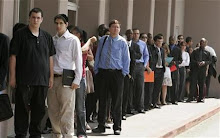 A 27-year-old Army veteran in full uniform lies dead with a twisted white sheet covering his body. The statue of a Civil War soldier stands over him, looking down as if to gaze at what had happened just a few feet away.
A 27-year-old Army veteran in full uniform lies dead with a twisted white sheet covering his body. The statue of a Civil War soldier stands over him, looking down as if to gaze at what had happened just a few feet away.The deceased man apparently used an assault rifle to shoot himself on the steps of the Veterans Affairs medical center in Dayton, Ohio. The man, who I will not name, enlisted in the Army in 2003 shortly after the Iraq invasion before leaving the service in 2007. Details of the soldier's suicide are vague, but it seems to be another reminder of the devastation inflicted on our citizens when they are sent to fight an unjust war.
But political feelings aside, why did The Associated Press feel the need to publish the photo of this man? How does it serve the story in any way besides to sensationalize his death? The AP used the full shot from the Dayton Daily News, which cropped the photo for its website.
There were plenty of times when I was sent out following a fatal car accident -- many times the person was ejected from the vehicle -- and the photographer declined to capture the shot or would not agree to have it published.
Using difficult photos is one of the most troublesome decisions for an editor. Some elicit strong emotional responses that would be tamed with a censored photo. But the details of this soldier's death are clear. And any good reporter would have been able to describe the sad scene, while also preserving this man's dignity.
UPDATE: 4:26 p.m. - In the few minutes after writing this post, the Post-Gazette and Associated Press have taken the non-cropped photo down from their websites.
Photo by Ron Alvey/Dayton Daily News





I've always had a "take the picture and worry about editing later" kind of motto in most cases. In this one, I think the body certainly makes for a more powerful photo, one that now can be found all over the web.
ReplyDeleteA photographer (and reporter, for that matter) should always shoot and then ask for forgiveness later. But tell me how often you see a photo of a dead body in the paper. Rarely is it acceptable. I've been on the scene of some gruesome crashes, but we didn't run the photo.
ReplyDeleteThere was no need for me or anyone else to see the body of this soldier in the photo.
The Pulitzer Prize-winning photo from the Kent State killings first comes to mind. The burning Buddha and My Lai massacre in Vietnam are others. There have been too many from Iraq and Afghanistan to count. Haiti. Ethiopia. Oklahoma. New Orleans. The Twin Towers.
ReplyDeleteGet back to me if/when this suicide photo wins a Pulitzer.
ReplyDeleteOne of the decisions I had to make as an editor involved whether to use the now-famous photo of the bloody child being carried from the Oklahoma City bombing. I used it. There were other cases in which I used photos that others might have deemed "too much." But the world is a place where many bad things happen, and I don't think a newspaper should be shielding its readers from unpleasantness. I wouldn't run a photo of a bloody body from a car accident, but on the other hand, if a country, say the U.S., is engaged in a war in which hundreds of billions of dollars are being spent and more than 4,000 soldiers have died, I don't think it's wrong to use a photo of a soldier killed in that war. People need to be reminded sometimes about the high, high toll of war, particularly the unnecessary ones. I can't speak to the photo about the suicide in Ohio, because I haven't seen the uncropped version. But I can tell you that the cropped photo of just the statue isn't worth shit. I don't know why anyone would run it.
ReplyDeleteI agree that each situation is different, but I don't think most suicides fit the bill for a photo. There was nothing special about this non-cropped photo in general that deemed it as a "must run" for the newspaper. This is where a good reporter could describe the scene and give more than enough information about what happened.
ReplyDelete